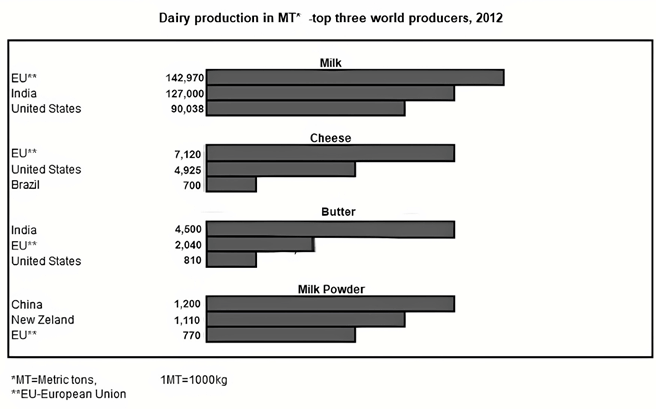5+ The charts below give information about the world's top three producers for four dairy products
The charts below give information about the world's top three producers for four dairy products (milk, cheese, butter, milk powder) in the year of 2012. Summarise the information by selecting and reporting the main features, and make comparisons where relevant. Write at least 150 words hay nhất giúp bạn có thêm tài liệu tham khảo để viết bài luận bằng Tiếng Anh hay hơn.
- The charts below give information about the world's top three producers for four dairy products (mẫu 1)
- The charts below give information about the world's top three producers for four dairy products (mẫu 2)
- The charts below give information about the world's top three producers for four dairy products (mẫu 3)
- The charts below give information about the world's top three producers for four dairy products (mẫu 4)
- The charts below give information about the world's top three producers for four dairy products (mẫu 5)
- The charts below give information about the world's top three producers for four dairy products (mẫu 6)
- The charts below give information about the world's top three producers for four dairy products (mẫu 7)
- The charts below give information about the world's top three producers for four dairy products (mẫu 8)
- The charts below give information about the world's top three producers for four dairy products (mẫu 9)
- The charts below give information about the world's top three producers for four dairy products (mẫu 10)
- The charts below give information about the world's top three producers for four dairy products (mẫu 11)
- The charts below give information about the world's top three producers for four dairy products (mẫu 12)
5+ The charts below give information about the world's top three producers for four dairy products
Đề bài: The charts below give information about the world's top three producers for four dairy products (milk, cheese, butter, milk powder) in the year of 2012. Summarise the information by selecting and reporting the main features, and make comparisons where relevant. Write at least 150 words
The charts below give information about the world's top three producers for four dairy products - mẫu 1
The bar graphs detail the output of leading three manufacturers globally for four various dairy items in 2012. Overall, the total production of milk from the three key contributors was significantly higher than the other consumables, followed by cheese, butter and milk powder. Moreover, while the European Union dominated in the quantity of milk and cheese produced, it ranked last in the manufacturing of powdered milk.
Concerning the categories in which the European Union produced the highest amount, it made nearly 143,000 metric tonnes of milk and about 7,100 metric tonnes of cheese. Furthermore, the amount of milk manufactured by India was 127,000 compared to roughly 90,000 metric tonnes made in America. Meanwhile, America and Brazil yielded 4,925 and 700 metric tonnes of cheese, respectively.
Regarding the other dairy staples, the most productive area for butter was India, at 4,500 metric tonnes, followed by the European Union and the United States, at approximately 2,000 and 810 metric tonnes, respectively. Finally, in terms of milk formula, China and New Zealand had a relatively identical amount of nearly 1,200 metric tonnes each, which was around 400 metric tonnes higher than the European Union.
The charts below give information about the world's top three producers for four dairy products - mẫu 2
The bar charts compare the production quantities of various dairy products by the world's top producers in 2012.
The European Union consistently emerged as a leading producer across all categories, except for milk powder.
The production of milk was highest in the European Union, at 142,970 metric tons, followed by India and the United States, with 127,000 and 90,038 metric tons respectively. In cheese production, while the European Union again led with 7,120 metric tons, the United States followed with a significant amount of 4,925 metric tons, overshadowing Brazil's production of 700 metric tons.
Regarding butter, a reversal in the leading position was observed with India surpassing the European Union, producing 4,500 metric tons compared to the latter's 2,040 metric tons. The United States trailed behind with 810 metric tons. In the milk powder sector, China outstripped other producers with 1,200 metric tons, closely followed by New Zealand and the European Union, which produced 1,110 and 770 metric tons respectively.
The charts below give information about the world's top three producers for four dairy products - mẫu 3
The bar chart presents data on the dairy production of milk, cheese, butter, and milk powder by the top three producers in 2012, with quantities measured in metric tonnes.
Overall, the European Union emerged as the predominant producer in the realms of milk and cheese, whereas India and China respectively secured the top spots in the production of butter and milk powder.
In milk production, the EU’s output reached 142,970 metric tonnes, constituting a notable 40% of the total production by the three leaders, surpassing India by approximately 15,000 metric tonnes and the United States by over 50,000 metric tonnes. Cheese production mirrored this trend, with the EU producing 7,120 metric tonnes, more than half the combined output of the next two largest producers.
Conversely, India dominated butter production, yielding 4,500 metric tonnes, a figure more than double that of the EU’s and substantially higher than the United States’ production of 810 metric tonnes. The production of milk powder showcased a different leader, with China at the forefront with 1,200 metric tonnes, marginally exceeding New Zealand’s production and significantly outstripping the EU’s output of 770 metric tonnes.
The charts below give information about the world's top three producers for four dairy products - mẫu 4
The bar chart in question delineates the production quotas of the foremost global dairy suppliers, categorising their outputs into four dairy segments: milk, cheese, butter, and milk powder for the year 2012. An analytical scrutiny of the data indicates a marked dominance by the European Union (EU), India, and the United States in the dairy production hierarchy.
In the realm of milk and cheese, the EU's production was unparalleled, with their dairy farms yielding 142,970 MT of milk and 7,120 MT of cheese, positioning them at the zenith of European dairy commerce. India was a formidable contender, securing the second rank in milk production at 127,000 MT, surpassing the United States by a significant margin of approximately 36,000 MT. The United States, however, manifested its dairy prowess in cheese production, generating 4,925 MT, a figure seven times higher than Brazil's contribution.
Transitioning to the realm of butter and milk powder, India's butter production reigned supreme, boasting a production volume of 4,500 MT, which more than doubled the EU's 2,040 MT and significantly overshadowed the United States' 810 MT. As for milk powder, China commanded the lead with a production of 1,200 MT, narrowly edging out New Zealand's commendable 1,110 MT and markedly outproducing the EU's 770 MT.
The charts below give information about the world's top three producers for four dairy products - mẫu 5
The bar chart provides a detailed illustration of information about the world’s top three producers of four different dairy products in 2012, encompassing milk, cheese, butter, and milk powder. This data highlights the production capacity of the European Union (EU), India, and the United States in these categories.
Overall, the EU was the market leader in milk and cheese production while India and China we the largest manufacturers of butter and milk powder, respectively.
In the arena of milk and cheese, the EU's prodigious output was unmatched. It produced 142,970 metric tons (MT) of milk and 7,120 MT of cheese, positions that underscored its supremacy in these segments. India emerged as the second most prolific milk producer, with its production totaling 127,000 MT, which was substantially more than the United States by 36,000 MT. In the cheese category, the United States demonstrated its strength by producing 4,925 MT, a volume significantly higher than Brazil's, being almost seven times greater.
In the sphere of butter and milk powder, leadership roles shifted. India's butter production took center stage with a remarkable 4,500 MT, surpassing both the EU's 2,040 MT and the United States' 810 MT. Conversely, China dominated in milk powder production with a yield of 1,200 MT, marginally outperforming New Zealand's 1,110 MT and considerably exceeding the EU's production of 770 MT.
The charts below give information about the world's top three producers for four dairy products - mẫu 6
The provided bar chart meticulously details the output of the world's top three producers of four different dairy products in 2012, measured in metric tonnes. A discernible pattern emerges, with the European Union (EU) taking the forefront in milk and cheese sectors, while India and China command the lead in butter and milk powder production, respectively.
For milk, the EU's production was unparalleled, registering at 142,970 metric tonnes, which underscores its role as a dairy powerhouse, outstripping India's robust yield by 15,000 metric tonnes and the US contribution by a considerable margin. Cheese production tells a similar story, with the EU producing a substantial 7,120 metric tonnes, dwarfing its competitors and accounting for over half of the total output among the top producers.
India’s predominance in butter production was marked, delivering an impressive 4,500 metric tonnes, more than quintupling the EU’s output, and eclipsing the United States' figure significantly. In the realm of milk powder, China edged into the lead with 1,200 metric tonnes, closely followed by New Zealand, leaving the EU trailing with 770 metric tonnes.
The charts below give information about the world's top three producers for four dairy products - mẫu 7
The bar charts delineate the top three countries by dairy production in the year 2012. Overall, it can be seen that the European Union was the only region featured in all categories, and milk output far outweighed that of other products.
In the chart for milk production, the European Union exhibited an aggregate of nearly 143,000 metric tons in 2012, surpassing India's production by approximately 16,000 metric tons. Ranked third was the United States with a milk yield of just 90,038 metric tons. Although cheese’s output was nowhere near as prolific as milk’s, it was the second most produced dairy. The European Union retained its role as the leader in this category, boasting an outcome of 7,120 metric tons. The United States followed suit with approximately 5,000 metric tons, seven times the figure for Brazil.
With an output of 4,500 metric tons, India was the foremost contributor to the world’s butter production, which was more than double the European Union’s output. The United States claimed the third position with 810 metric tons. In comparison, milk powder production in the surveyed countries hovered around 1,000 metric tons, with China and New Zealand occupying the first and second place, respectively. Meanwhile, the third place belonged to the European Union, with 770 metric tons.
The charts below give information about the world's top three producers for four dairy products - mẫu 8
The bar chart illustrates the four dairy production outputs of the top three producers in 2012.
Overall, milk stood out as the most significant, whereas milk powder occupied the position of the least produced in the market. Moreover, the European Union emerged as the global leader in producing milk-based products.
Regarding the global dairy industry, the European Union (EU) dominated milk products, recording a remarkable 142,970 MT. Subsequently, India secured the second-highest rank, contributing significantly with 127,000 MT, while the United States trailed with just over 90,000 MT. In the milk powder section, the EU yielded a quantity of 770 MT, yet the primary contributors in this category are China and New Zealand, with a substantial 1,200 MT and 1,100 MT, respectively.
When it comes to cheese, the European Union (EU) surpassed competitors, providing 7,120 MT, outclassing both the United States, which provided 4,925 MT, and Brazil, contributing 700 MT. Conversely, the amount of butter made by the EU was approximately 2,000 MT. India distinguished itself by supplying 4,500 MT, showcasing its more significant role in dairy goods.
The charts below give information about the world's top three producers for four dairy products - mẫu 9
The charts demonstrate the three leading producers for four types of dairy products worldwide in 2012. Overall, a larger amount of milk was produced compared to other products. Additionally, while the European Union made the most milk and cheese, India was the top manufacturer of butter and China dominated milk powder production.
With regard to milk and cheese production, in the European Union the former stood at 142,970 metric tons, compared to 127,000 metric tons in India and 90,038 metric tons in the United States. In the same year, the European Union produced 7,120 metric tons of cheese, followed by 4,925 metric tons in the United States, and Brazil was far behind with only 700 metric tons.
Concerning the remaining products, butter production in India was recorded at 4,500 metric tons, more than double the figure for the European Union with 2,040 metric tons. However, just 810 metric tons of butter was made in the United States. Such a discrepancy was not seen in milk powder as the data for China and New Zealand were relatively comparable at 1,200 and 1,110 metric tons respectively, whilst the European Union manufactured 770 metric tons of milk powder.
The charts below give information about the world's top three producers for four dairy products - mẫu 10
The bar chart compares the dairy production among the world's top three producers for the year 2012.
It is clear that in all the three regions, more milk was produced than other types of products. European Union was the primary producer of milk and cheese, while India and China took precedence in butter and milk powder production respectively.
In terms of milk output, EU took the lead with a substantial production of 142,970 metric tons, significantly surpassing the production in India by roughly 16,000 metric tons and that in US by around 50,000 metric tonnes. Likewise, EU still maintained its leading position in cheese production (7,120 metric tons), while Brazil only produced 700 metric tons of cheese.
However, with an output of 4,500 metric tons, India dominated butter production, a figure more than twice of the combined production in EU and US. A different pattern could be found in the production of milk powder. China ranked the top in this item (1,200 metric tons), closely followed by the figure in New Zealand (1,110 metric tons). The third largest producer was the EU, with 770 metric tons of milk powder produced in this area.
The charts below give information about the world's top three producers for four dairy products - mẫu 11
The bar chart compares three leading countries on a worldwide scale in terms of their production of four types of dairy products, namely milk, cheese, butter and milk powder in the year 2012. The unit of measurement is metric tons (MT).
Overall, a similar pattern could be seen in all of the three major world producers, with the EU consistently being the primary manufacturer of four kinds of dairy products, followed by India and the United States (US). In addition, among the four categories, milk was by far the most commonly produced one, significantly surpassing the figures for milk powder.
The EU was the dominant producer of milk, manufacturing slightly under 150000 MT, and this was followed closely by India, whose production of the same product was approximately 130000 MT. By contrast, the US lags behind, having the least amount of milk produced (around 90000 MT). Milk powder almost exactly followed a similar pattern to that of milk, albeit at a far lower rate. The majority of this type of product was made in the EU (marginally below 1250 MT), whereas India and the US produced lower quantities, with respective figures being roughly 1100 MT and just over 750 MT.
Regarding butter, a considerable difference of about 2500 MT was witnessed in butter production, with the EU far outnumbering its Indian counterparts. While the former produced nearly 4500 MT, the figure for the latter was only 2000 MT. India produced nearly twice as much butter as the US, with the data for the US standing at a mere 800 MT. Finally, about 7000 MT of cheese was produced in the EU, as opposed to India, which accounted for close to two-thirds of the EU’s amount, at 5000MT. Notably, the lowest recorded figure occurred in cheese production in the US, where as low as 500 MT of this product was manufactured.
The charts below give information about the world's top three producers for four dairy products - mẫu 12
The charts provide data about the production of milk, cheese, butter and milk powder by the highest world producers in 2012.
Overall, the European Union (EU) led the way in milk and cheese production. In terms of metric tons, the production of milk far exceeded that of the other dairy products.
The EU produced almost 143,000 metric tons of milk, compared with 127,000 metric tons in India and around 90,000 metric tons in the USA. The production of cheese in the EU was just over 7,000 metric tons, while the USA produced almost 5,000 metric tons and Brazil produced 700 metric tons.
India led world production of butter with 4,500 metric tons, more than double the figure for the EU, with production in the USA totalling just over 800 metric tons. Finally, China produced 1,200 metric tons of milk powder, a slightly higher figure than in New Zealand and the EU, with 1,110 and 770 metric tons, respectively.
Xem thêm các bài luận Tiếng Anh hay khác:
Đã có app VietJack trên điện thoại, giải bài tập SGK, SBT Soạn văn, Văn mẫu, Thi online, Bài giảng....miễn phí. Tải ngay ứng dụng trên Android và iOS.
Theo dõi chúng tôi miễn phí trên mạng xã hội facebook và youtube:Nếu thấy hay, hãy động viên và chia sẻ nhé! Các bình luận không phù hợp với nội quy bình luận trang web sẽ bị cấm bình luận vĩnh viễn.
- Đề thi lớp 1 (các môn học)
- Đề thi lớp 2 (các môn học)
- Đề thi lớp 3 (các môn học)
- Đề thi lớp 4 (các môn học)
- Đề thi lớp 5 (các môn học)
- Đề thi lớp 6 (các môn học)
- Đề thi lớp 7 (các môn học)
- Đề thi lớp 8 (các môn học)
- Đề thi lớp 9 (các môn học)
- Đề thi lớp 10 (các môn học)
- Đề thi lớp 11 (các môn học)
- Đề thi lớp 12 (các môn học)
- Giáo án lớp 1 (các môn học)
- Giáo án lớp 2 (các môn học)
- Giáo án lớp 3 (các môn học)
- Giáo án lớp 4 (các môn học)
- Giáo án lớp 5 (các môn học)
- Giáo án lớp 6 (các môn học)
- Giáo án lớp 7 (các môn học)
- Giáo án lớp 8 (các môn học)
- Giáo án lớp 9 (các môn học)
- Giáo án lớp 10 (các môn học)
- Giáo án lớp 11 (các môn học)
- Giáo án lớp 12 (các môn học)






 Giải bài tập SGK & SBT
Giải bài tập SGK & SBT
 Tài liệu giáo viên
Tài liệu giáo viên
 Sách
Sách
 Khóa học
Khóa học
 Thi online
Thi online
 Hỏi đáp
Hỏi đáp

